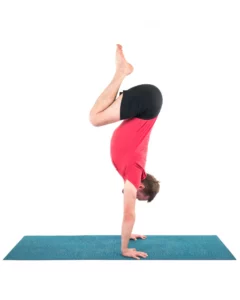Turning Back the Clock – Progressive Resistance Training Key to Preventing Muscle Loss

Did you know that, according to the Mayo clinic, after age 50 our muscles lose 10% to 15% of their size and strength every year? This is particularly true for those who are inactive. However with strength-training exercises, including yoga and resistance training, you may be able to increase muscle mass and grow stronger during your Golden Years, say experts at the University of Michigan Health Center.
Progressive resistance exercise is the key to increasing lean muscle mass and strength, according to Mark Petersen, PhD, a research fellow at the University of Michigan’s Physical Activity and Exercise Intervention Research Laboratory. And while resistance training typically is done with weights, numerous yoga postures use the weight of the body to achieve similar effects.
Use It Or Lose It Starts As Early As 30+
Muscle loss continues as people age with the greatest loss coming in one’s senior years. But physicians are seeing declines as early as in the 30s and 40s and 50s, particularly in people with a sedentary lifestyle.
Ongoing research from the National Institutes on Aging shows that building our strength capacity as we age helps us to maintain muscle mass, improve mobility, and increase our health-span. With resistance exercise, older adults can continue to do the types of movements that we take for granted most of our lives, such as standing up out of a chair, climbing a flight of stairs, or even walking across the floor. People well into their 80s and 90s can see substantial strength improvement and remain strong and active using progressive resistance exercises.
Progressive resistance training entails altering the amount of weight used, frequency, and duration of training sessions according to an individual’s progress. In traditional weight training this is done by increasing the size of the weights lifted. In yoga postures, similar effects can be achieved by always challenging yourself to go to the edge of your comfort zone in weight-bearing postures, and including multiple repetitions going in and out of weight-bearing poses.
Traditional resistance training classes incorporate squats, modified push ups, standing up out of a chair, lying hip bridges along with weight lifting. Yoga postures best suited for similar progressive strengthening, include yoga exercises like Plank pose, arm balancing yoga postures, as well as most all the standing postures, including the Warrior poses, Chair pose, and playful balancing postures like Ardha Chandrasana and Vrksasana, Tree pose.
Research from the University of Michigan underscores just how much progressive strength training can do to halt the onslaught of muscle loss. The study, published in the American Journal of Medicine, found that adults practicing progressing resistance training over an 18-20 week period added 2.42 pounds of lean muscle to their body mass and experienced a 25-30% strength increase.
Adults in their 50s, 60s, 70s and beyond have different needs than those in their 20s, and Peterson recommends you seek out a certified trainer or professional experienced in working with older individuals as they are better equipped to provide guidance that can ensure your safety.
Petersen says strengthening exercises should be done a minimum of twice a week – and ideally more. A steady increase, little by little, will give you the best overall results, long term, for increasing your strength and stability. A yoga teacher or fitness professional can guide you and adjust your regime as you increase your muscle mass. Not only will you be stronger for your efforts, but you will continue to enjoy your favorite activities throughout life.



